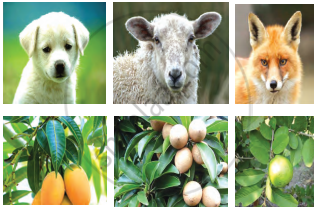Advertisements
Advertisements
प्रश्न
Observe the given images and answer the following questions.

- Which evolutionary evidence does it indicate?
- What does it prove?
- State another example of evolutionary evidence.
उत्तर
- The given picture indicates the morphological evidence of evolution.
- Morphological evidence is based on the similarity of size, shape or structure of organs among a group of organisms proving that they evolved from the same ancestor.
- Other examples of evolutionary evidence: Anatomical evidence, paleontological evidence, vestigial organs, embryological evidence, connecting links.
APPEARS IN
संबंधित प्रश्न
Which of the following pairs of two vegetables represent the correct homologous structures?
(A) Sweet potato and potato
(B) Sweet potato and tomato
(C) Carrot and potato
(D) Radish and carrot
Select two pairs from the following which exhibit divergent evolution. Give reasons for your answer.
(i) Forelimbs of cheetah and mammals
(ii) Flippers of dolphins and penguins
(iii) Wings of butterflies and birds
(iv) Forelimbs of whales and mammals
How analogy and homology considered as an evidence in support of evolution ?
State a reason for the increased population of dark coloured moths coinciding with the loss of lichens (on tree barks) during industrialization period in England.
Can the wing of a butterfly and the wing of a bat be considered homologous organs? Why or why not?
Find out from newspapers and popular science articles any new fossil discoveries or controversies about evolution.
Enlist any four sequential evolutionary names of human ancestors.
Give the importance of fossil in support of organic evolution
Explain with an example for the given, how the following provides evidence in favor of evolution in organisms :
Analogous organs
Name the scientists who Discovered the fossil of Australopithecus
Explain the evolution of giraffe's neck according to Lamarck's theory of evolution.
Differentiate between analogous and homologous structures.
Name two animals having homologous organs and two having analogous organs. Name these organs.
The presence of which of the following types of organs in two organisms indicates that they are derived from the same ancestor?
(a) analogous organs
(b) respiratory organs
(c) digestive organs
(d) homologous organs
One pair of organs in the following animals are not homologous. This is :
(a) forelimbs in humans and lizard
(b) forelimbs in lizard and frog
(c) wings in butterfly and bat
(d) wings in bat and bird
There are five animals A, B, C, D and E. The animal A uses its modified forelimbs for flying. The animal B uses its forelimbs for running whereas the animal C uses its forelimbs for grasping. The animal D can live on land as well as in water and uses its forelimbs to prop up the front end of its body when at rest. The animal E which respires by using spiracles and tracheae uses wings for flying but its wings are analogous to the modified forelimbs of animal A.
(a) What could the animals A, B, C, D and E be?
(b) Why are the forelimbs of animals A, B, C, D called homologous organs?
(c) What does the existence of homologous organs in animals A, B, C and D tell us about their ancestors ?
(d) Why are the modified forelimbs of animal A and the wings of animal E called analogous organs?
(e) State whether animals A and E have a common ancestor or not.
The organs P and Q of two animals have different structures but similar functions. On the other hand, the two organs R and S of two other animals have the same basic structure but different functions.
(a) What are the organs like P and Q known as?
(b) Name the organs like P and Q. Also name the animals which have such organs.
(c) What are the organs like R and S called?
(d) Name the organs like R and S. Also name the animals which have such organs.
Identify the following pairs as homologous and analogous organs:
(i) Sweet potato and potato
(ii) Eye of octopus and eye of mammals
(iii) Thorns of Bougainvillaea and tendrils of Cucurbits
(iv) Fore limbs of bat and whale
In a class, students were asked to observe the models/slides/pictures of the skeletons of forelimbs and wings of different organisms. After the observations the students made the following groups of homologous structures. Select the correct group :
(A) Wings of a bird and a butterfly
(B) Wings of a pigeon and a bat
(C) Wings of a butterfly and a bat
(D) Forelimbs of a cow, a duck and a lizard
Vestigial organ ______ present in human body is proof of evolution.
Write the names of those animals in whom the human body organs are functioning.
Complete the following chart:

Choose the correct option of the following question:
Wings of Insect and Birds are examples of :
Differentiate between connecting links and the missing links.
Find an odd one out.
Give scientific reason.
Peripatus is said to be the connecting link between Annelida and Arthropoda.
The degenerated and non-functional organs found in an organism are called ______.
- Define vestigial organs.
- Write names of any two vestigial organs in the human body.
- Write name of those animals in which these vestigial organs are functional.
Homologous organs are:
Appearance of antibiotic-resistant bacteria is an example of ______.
How do we compute the age of a fossil?
Complete the following diagram:

Explain natural selection with the example of industrial melanism.
Define the term:
Homologous organs
Industrial melanism was highlighted by ______.
